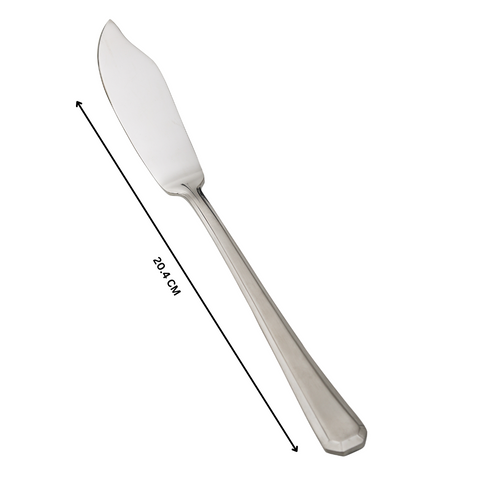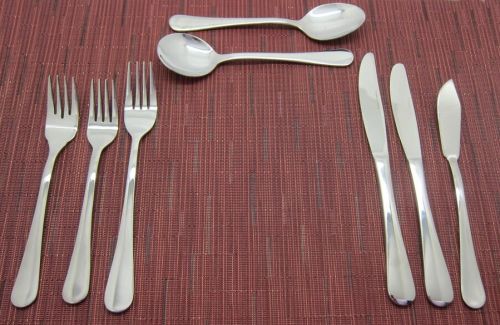Discover the Vital Features to Seek in a Top-Quality Fish Knife
When picking a fish knife, several essential features require interest. The blade material significantly impacts toughness and intensity, while versatility plays an important role in accuracy. Furthermore, the handle design influences convenience during extended usage. Edge retention and security features are also crucial for sensible use. Understanding these components will certainly direct customers toward making an educated option, yet the subtleties of their importance may not be immediately clear.
Blade Product and Building
The performance of a fish knife largely rests on its blade product and building and construction - fish knife. High-grade fish blades usually include blades made from stainless steel, high-carbon steel, or a mix of both. Stainless steel is favored for its deterioration resistance and low upkeep, making it optimal for freshwater and deep sea environments. High-carbon steel, while susceptible to rusting, supplies exceptional sharpness and side retention, appealing to those that focus on cutting performance
The building and construction of the blade likewise plays a crucial function in its performance. Full-tang blades, which extend the entire length of the manage, give boosted strength and equilibrium. On the other hand, partial-tang blades may compromise longevity. Additionally, the thickness of the blade ought to be taken into consideration, as thinner blades allow for more accurate cuts, crucial for delicate fish filleting. Ultimately, a well-constructed blade, utilizing the best products, is basic for achieving the most effective outcomes when preparing fish.
Blade Adaptability and Size
Blade adaptability and size are crucial elements that substantially affect the efficiency of a fish knife. An adaptable blade permits accurate cuts and the capability to navigate around bones and skin, making it vital for filleting fish efficiently. The correct amount of versatility can improve control, making it possible for the customer to attain clean, smooth cuts with very little effort.
In regards to length, fish knives commonly vary from 6 to 9 inches. A longer blade is helpful for larger fish, offering the reach needed for reliable filleting. On the other hand, a shorter blade offers ability to move, making it suitable for smaller sized fish or complex tasks.
Inevitably, the option of flexibility and size ought to align with the specific fishing needs and choices of the customer. A healthy mix of these qualities guarantees optimum performance, boosting the general fish prep work experience.
Handle Style and Convenience
A properly designed handle is important for making certain convenience and control when using a fish knife. The deal with must fit securely in the hand, permitting a company grasp throughout intricate tasks such as filleting or skinning fish. Products like rubber, timber, or composite offer various degrees of convenience and traction, affecting the customer's experience.
Ergonomic features are likewise essential; shapes that comply with the all-natural shape of the hand can minimize exhaustion throughout prolonged use. Additionally, the handle's structure plays a considerable duty in avoiding slippage, specifically when collaborating with damp hands.
Weight circulation is an additional variable that adds to the overall balance of the knife, boosting maneuverability. A comfy take care of layout not just improves efficiency yet likewise promotes safety and security, as a safe and secure hold decreases the risk of mishaps (fish knife). Ultimately, a thoughtful take care of layout can considerably raise the efficiency of a fish knife in cooking applications
Edge Retention and Sharpening
While using a fish knife, keeping a sharp side is important for accomplishing clean cuts and accurate filleting. A quality fish knife should show superb edge retention, enabling it to stay sharp via several uses. This characteristic is frequently figured out by the type of steel made use of in the blade; high-carbon stainless steel is frequently favored as a result of its equilibrium of firmness and corrosion resistance.

Security Functions and Sheath Options
Many security functions and sheath options are necessary considerations when selecting a fish knife. A secure and ergonomic take care of decreases the risk of slides throughout use, enhancing user safety. Textured holds and finger guards even more prevent crashes, permitting better control while filleting fish.
Furthermore, a blunt suggestion can minimize the risk of slit injuries, making it a safer selection for newbie individuals.
Sheath options likewise play a crucial duty in safety and security. A properly designed sheath safeguards the blade, stopping unintentional cuts when the knife is saved or delivered. Sheaths made from long lasting materials, such as nylon or tough plastic, offer included protection versus environmental components.
Some sheaths come with belt clips or loopholes, ensuring the knife is conveniently accessible while staying protected. Eventually, focusing on safety functions and sheath alternatives contributes dramatically to the general performance and customer experience of a fish knife.
Frequently Asked Concerns
What Is the Ideal Brand for Fish Knives?
The very best brand name for fish blades typically differs by choice, but prominent names like Wüsthof, Victorinox, and Avoid are often recommended for their craftsmanship, durability, and sharpness, making them top choices amongst cooking fanatics and specialists alike.
Can Fish Knives Be Used for Various Other Kinds of Fish?
Fish blades can indeed be used for various other kinds of fish. Their design and intensity make them functional sufficient for numerous fish types, enhancing the total experience of filleting and preparing various kinds of seafood.

How Do I Clean and Preserve My Fish Knife?
To clean up and keep a fish knife, wash it with warm water after usage, gently scrub with moderate soap, dry completely, and store in a safety sheath to avoid damage and corrosion. Normal developing is vital.
Are There Fish Blades Especially for Left-Handed Users?
Yes, there are fish blades designed particularly for left-handed individuals. These blades include reversed blade angles and ergonomic takes care of, ensuring convenience and performance for left-handed individuals while filleting and preparing fish. Quality options are available from numerous suppliers.
What Is the Rate Range for High Quality Fish Blades?
Quality fish knives normally vary from $20 to $150, depending upon materials, brand online reputation, and workmanship. Higher-end alternatives may feature specialized designs and exceptional ergonomics, while economical selections still provide sufficient efficiency for casual users.
The effectiveness of a fish knife greatly pivots on its blade material and construction. Top notch fish knives generally feature blades made from stainless steel, high-carbon steel, or a mix of both. Blade versatility and size are vital elements that considerably influence the performance of a fish knife. Fish knives can without a doubt be utilized for various other types of fish. These blades feature reversed blade angles and ergonomic takes care of, guaranteeing convenience and effectiveness for left-handed people while filleting and preparing fish.